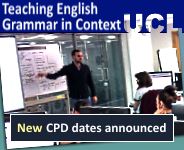Verb endings
In this activity we will look at suffixes which change adjectives and nouns into verbs. This process is a part of derivational morphology.
Welcome back!

Englicious is totally free for everyone to use!
But you will have to log in to see our library of teaching resources.
If you don’t have an account, that’s perfectly OK. You can register (for free).
It only takes a minute or two.
»
- Printer-friendly version
- Log in to view or leave comments

